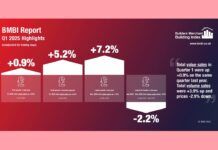Rachel McHugh, managing director at creative marketing and PR agency, Clear B2B, shares her thoughts on how those in the building and construction industry can get the most out of their marketing activity post-COVID-19.
The building and construction industry is an inherently competitive one – a fact only accentuated by the COVID-19 pandemic. Reduced construction output and increased pressure on margins will mean that businesses need to work hard to keep their customers and win new clientele. With all brands vying for a greater share of the industry, marketers need to keep innovating and assessing their approach to stay ahead of the competition. Let’s look at how.
We’ve seen, for instance, customers’ expectation for efficiency increase, meaning that brands’ have had to quickly adapt to a new way of doing things, from online conferences and virtual networking, to shopping digitally for essentials.
Now more than ever, prioritising customer experience will help brands stand out and build a loyal customer base. We expect this to continue way beyond the pandemic era. Brands who are doing their absolute best to provide a good service during these trying times are already seeing appreciation for their efforts. Those who can continue such high levels of service, engagement and transparency will ultimately win.
Know your audience better than they know themselves
It may seem obvious, but to truly reach your audience, you need to know them inside out. It’s easy to let this slip or disregard because you “already know them”, but your audience and how they prefer to be communicated with is constantly shifting. So, take this time to get back to the grassroots and take a fresh look. Speak to your employees at the sharp-end of your business. After all, they’re the ones on the front line, speaking with your customers and clients, day in day out, hearing feedback first-hand and picking up trends. This exercise can be run independently or via moderated focus groups.
More and more, customers’ expectations in the business-to-business (B2B) world are influenced by their consumer experiences. They expect the best. Some food for thought from Salesforce’s State of the Connected Customer report: fifty-seven percent of people surveyed said that they’ve stopped buying from a company because a competitor provided a better experience. Meanwhile, 67% percent of customers say their standard for good experiences are higher than ever, while 69% expect Amazon-like buying experiences. The benchmark has been set. Customers expect the same high-end level of service across the board, regardless of what they’re buying, so you need to ask yourself: “Why would a customer choose your brand over one of your competitors?”.
The solution? Plot your customers’ journey versus your competitors and identify where your business falls down and/or where it has an edge. Then explore how technology can help to improve your customers’ experience. Inspiring your customers with innovative solutions, whether it’s a chatbot, voice-activated personal assistant or an artificial intelligence brand ambassador, is essential. Sixty-six of buyers, according to Salesforce’s report, actively seek to buy from the most innovative companies.
Are you an educator?
Consumers demanding valuable information from the businesses they engage with is a growing trend, so adopting an educational approach – and positioning your business as the go-to source for knowledge and information within the industry – is absolutely necessary.
Your business and the experts within it have thoughts and opinions that make them unique. Be sure to use them! Curate content – whether it be editorial, infographics or videos – that provides insight and solves customers’ common problems; take views on popular trends and create a unique angle on it. Whatever you do, make sure it has your stamp of identity on it. Demonstrating your authority within the market increases your influence and influence persuades people to buy.
Getting personal
A recent Forbes report suggests that a huge 72% of buyers expect companies to personalise communications in a way that suits their needs. And remember, these buyers will quickly switch to another company if they believe their needs can be better catered for elsewhere.
All communications should therefore be tailored to the individual customers’ preferences – it is what customers have come to expect. But this doesn’t just include segmenting by sub-industry, but by also personalising names, company details and buying preferences. As an example, email marketing – executed via automated programmes – is where personalisation really comes to the fore. It enables you to send communications instantly based on triggers and to a smaller segment to which the message is relevant, all while saving time by reducing manual tasks. In short, by sending emails which are tailored to customers’ likes, dislikes, profile information and overall behaviour, they’re less likely to become uninterested and unsubscribe.
Take social seriously
For many B2B businesses, COVID-19 has propelled social media into the boardroom and stakeholders are finally giving it the attention it deserves. In a limited-contact society that’s increasingly buying online, social media can present your content, organisation, brand, culture and offerings in a way that inspires engagement. Remember, to grab attention, social media posts have to be succinct, yet powerful and that takes adequate investment in ideas and execution.
Fly the flag for the industry
It’s an industry your business is deeply passionate about, so champion it! Shout about the good work being done in the merchant and wider building and construction industries, and how your employees are helping. Highlight your sustainability credentials, promote safety, help to develop people’s skills, and encourage innovation. Whatever it might be, it’s beneficial for both your business and the industry generally, so don’t leave it out of your marketing mix.
What does history tell us?
The knee-jerk reaction to a crisis is to hunker down and protect short-term profitability, but brands that hold their nerve and retain visibility will gain extra share of voice and achieve competitive gains. The data proves as much: research from Kantar shows that 60% of brands that “go dark” during an economic downturn saw their brand use decrease by 24% and brand image by 28%.
Kantar also estimates that brands who go dark to save costs will likely see a 39% reduction in brand awareness. McGraw-Hill Research looked at 600 companies from 1980 to 1985, and showed that those that maintained or increased their marketing spend during the 1981 recession had sales that were 256% higher than those that didn’t by 1985.
The bottom line? Businesses that continue to maintain their share of voice and share of market during a downturn have shown a longer-term improvement in profitability, outweighing short-term savings.
If you need help unlocking your business’s marketing potential, then you can get in touch with Rachel on +44(0)1285 626000 / r.mchugh@clearb2b.com, or visit Clear B2B’s website at www.clearb2b.com.




